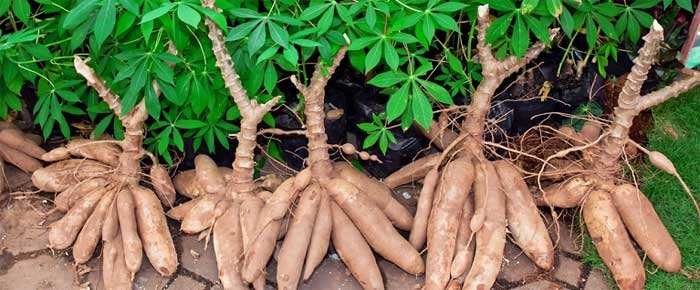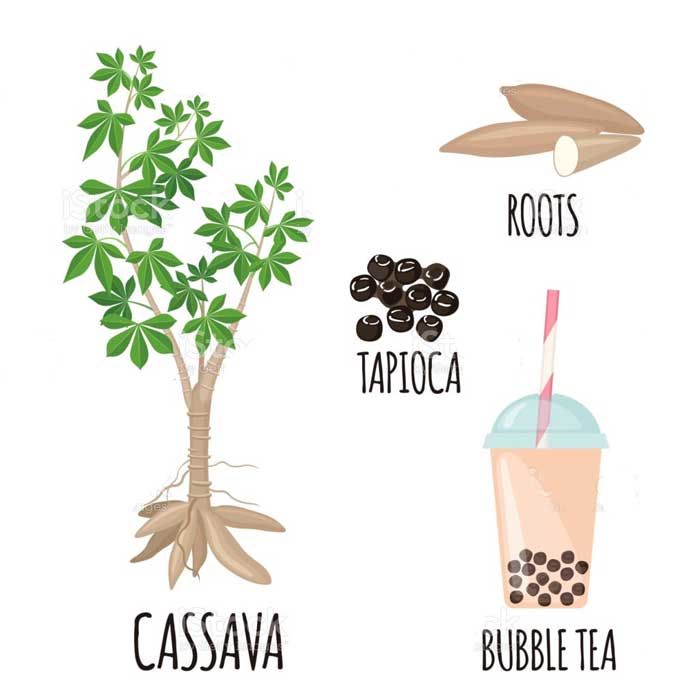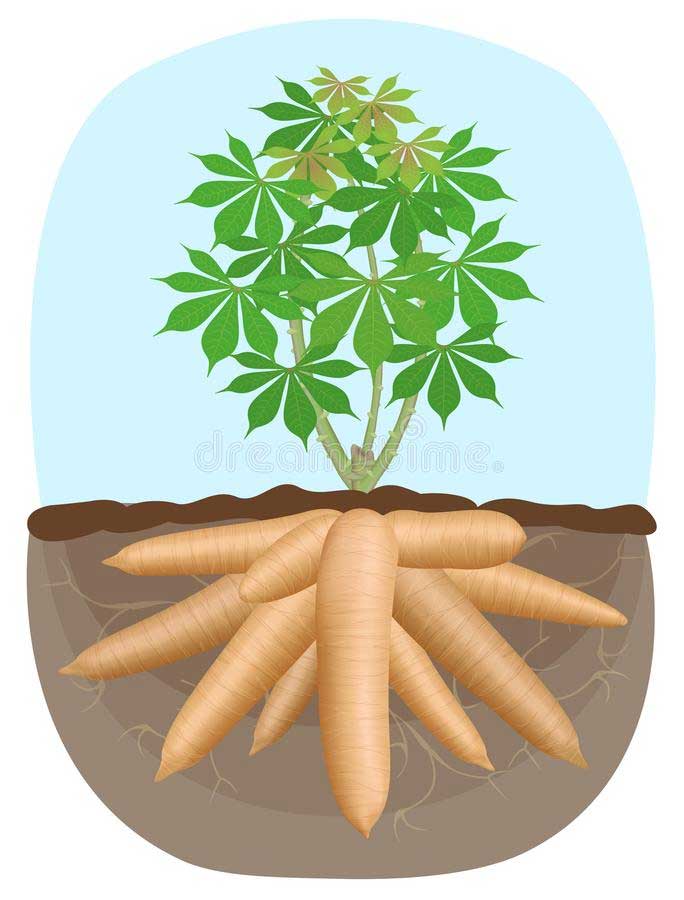The tapioca plant is a tropical, tuberous herb that is native to Brazil. The plant is cultivated for its starchy root, which is used in a variety of food products and the leading producers include Thailand, India, and China.
The primary use of tapioca is as an ingredient in food products. Tapioca is also used to make tapioca pearls, which are small balls of the starchy root that are often used in desserts or as a garnish.
Overview
The tapioca plant Manihot esculenta, a member of the Euphorbiaceae (spurge) family that includes poinsettias and castor oil plants, is a tropical plant native to South America. It has some resemblance to the castor bean plant (Ricinus communis), with its typical form; nevertheless, its seedpod structure is not as thorny as that of castor.
It’s occasionally referred to as yuca; however because there is only one ‘c’ between it and the big succulent plant yucca
Health Benefits Of Tapioca
Tapioca contains several minerals that may help you live a long life. You should also consider reading money plant benefits as well here.
Diabetes Control
In a study, insulin resistance was considerably lower in the mice fed with tapioca starch compared to those who didn’t get it.
Digestive Health
Tapioca is easily digested, making it an excellent choice for those suffering from IBS and other digestive difficulties.
Nutrition
Tapioca starch is cholesterol-free and fat-free, making it a healthy option for people on a diet that limits cholesterol and saturated fat. Tapioca is also low in salt. One serving offers 20 milligrams of calcium and 1.6 milligrams of iron.
Have a look at jade plant benefits here as well.
Structure of Tapioca Plant
Leaves and Stem
The leaves of the yam plant are fanned out into palmately lobed shapes that would instantly earn a tropical atmosphere. The leaves are particularly profuse in the early phases of development, but as time goes on, the lower leaves fall off and the plant develops a long cane topped with a tiny umbrella of foliage. Individual leaf sizes are reduced as branching proceeds.
Variegated Foliage and Flowers
The most typical variegation is cream and green, but you’ll find green and brilliant yellow foliage with pink-red leafstalks as well. The flowers of the Sefloria genus are small and insignificant when compared to those of other Euphorbiaceae, and castor bean-shaped seeds are kept in pods that break open when dry.
Also read spider plant benefits here.
Tubers
The tapioca tubers are found underground in large clusters at the bottom of the stem. There’s a long, hard thread running down the middle of the tuber; it’s the root’s tough core.
Toxicity
Regardless of the variety, they all include anti-nutrients and cyanide-forming chemicals. This ancient crop has evolved over millennia to serve as a protective mechanism. Nothing from the plant should be consumed raw or given to livestock.
- The sweet variety is low in hazardous chemicals and can be cooked without harming them. Before consuming, boil and drain the sweets and water.
- The extremely bitter ones have many times the amount, and it requires more processing to make them safe to consume.
- Gardeners should not attempt to gather or process the severe cultivars on their own.
- Have a look at snake plant benefits while brining it home or growing it in garden.
Tip to Grow Tapioca Plants
They may be cultivated in USDA zones 8-11 in the garden, as well as indoors in colder climates. They thrive in Florida, where they grow easily and naturally. With little effort and care, you can effortlessly cultivate them.
Obtaining the Plant
The most difficult part of growing cassava is often obtaining the planting supplies. If you can’t discover any cassava plants in a local nursery, check out online retailers who will send you a few cuttings by mail.
The starch-rich roots of tapioca are what distinguish it from other species of tapioca. This implies that cutting portions from tapioca tubers does not produce new plants; they don’t have dormant buds or eyes to start with.
You’ll need either stem cuttings or viable seeds to get started.
Here is all about areca palm plant you should know about.
Stem Cuttings
It’s difficult to determine the head from the tail once you’ve cut the stem into pieces, so follow these easy techniques to avoid that confusion.
- To coat the whole length of a long cane, dip the cut end in dirt.
- Remove a one-foot section and save it for later.
- To coat the freshly cut end of the long cane, submerge it in the dirt.
- Make the nest from a length of the cane, and repeat the process until you’ve used up all of your materials.
- Each of the cuttings has a soil-stained end now. When you plant each one, this is the end that should go into the ground.
Want to know how to identify fake insulin plant? Here you go.
Planting Cassava
After tilling the soil well with compost and manure, make a bed in furrows and ridges. They should be planted halfway into the earth with their edges slanted at an angle to allow for proper headroom for future growth. Water every other day if you water properly, and you’ll notice new growth within a week or two.
Basic Maintenance
Your tapioca tubers will fatten up in approximately eight to ten months if you water and feed them regularly.
Pests and Diseases
Cassava is resistant to pests due to the toxic chemicals in its plant tissue, although mass cultivations may be damaged. If you find Aphids and Whiteflies on your crop, a light spray with water should be sufficient to remove them.
Harvesting
It won’t be sticky enough if you harvest it too early, and you’ll end up with fibrous tubers if you wait too long.
- Remove the top layer of soil carefully with a spade, working your way down toward the tubers.
- Remove the earth from between the tubers using a pickaxe.
- To release the clump from the dirt, hold the stump and wiggle it back and forth. It makes things simpler if the soil is a little moist.
- Have a look at touch me not plant here with its uses, benefits, side effects, etc.
How to Cook Tapioca in the Kitchen?
The flesh is firmer, with a chalkier feel to it. Tapioca may have various tastes and textures depending on the time of harvest, similar to new potatoes vs. mature spuds.
- They may be cooked in water or roasted over an open fire.
- Smaller pieces of cauliflower, when sliced and cooked like potatoes in stews and meat curries, may be used effectively.
- The root can be dug up and sieved to produce tapioca meal, which is a nutritious starch.
- Tapioca pearls, while tiny, can thicken dishes and stews.
Also read about rubber plant care here.
Conclusion
If you’re looking for a new addition to your garden, consider adding cassava to your list of possibilities. Look at the above information on how to grow and care for this plant, as well as how to cook it in the kitchen. You’ll be sure to enjoy the versatility and flavor of this humble tuber.



Being entirely made up of starch, tapioca provides very little protein and other nutrients.
Flour can be replaced with tapioca while baking and cooking. Desserts like puddings and bubble tea are frequently made using it.